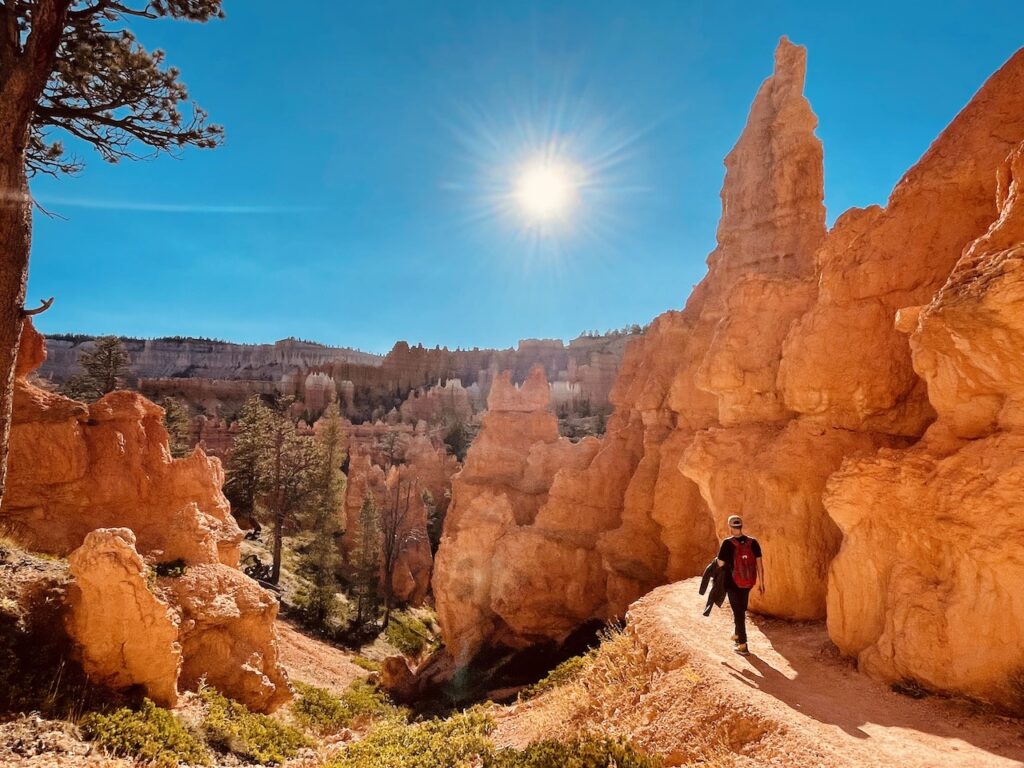October 2023 we visited 6 national parks and many other famous natural landmarks and drove over 4,800 miles (7,726 km) in an RV with four people and two dogs. Here’s how our road trip went:
Pennsylvania to Mesa Verde National Park, Colorado (Oct 8-11)
We rotated drivers every few hours, making the trip in three days. To optimize stops, we walked the dogs and refueled at the same time. Instead of RV parks, we used rest stops and truck stops. We would sleep for 4-6 hours before continuing our journey.
Mesa Verde National Park
This was a surprisingly well-developed national park. The welcome center has a sizeable exhibit showcasing the history and culture of the Ancestral Puebloans. These indigenous peoples inhabited this region for over 700 years. They transitioned from a nomadic lifestyle to permanent settlements, building elaborate cliff dwellings for protection. For unknown reasons, these communities began abandoning their homes in the late 1200s. Mesa Verde became a national park in 1906 to protect these archaeological sites.
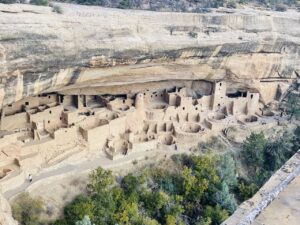
Hiking and Tours: You can hike the Spruce Tree House Trail and the Step House Trail on Wetherill Mesa without a guide. However, the Cliff Palace Loop, Balcony House Trail, and Long House Trail require a guided tour for access to the cliff dwellings.
Best Time to Visit: Late spring (April to June) and early fall (September to October) due to mild weather and fewer crowds.
Note: In winter or inclement weather, some trails and facilities may be closed. Summer often sees crowded trails and afternoon thunderstorms.
Mesa Verde to Monument Valley, Navajo Nation (Arizona-Utah border) (Oct 12-13)
We had stayed one night at an RV park just five minutes from Mesa Verde. The next day, we drove approximately 90 miles to Monument Valley.
Monument Valley
The skies in Monument Valley are the most beautiful I have ever seen. This desert region is known for its stunning sandstone buttes. A butte is a rock formation with a flat top and steep sides, formed by erosion. Monument Valley is sacred to the Navajo people and has been a backdrop for many Western films since the 1930s. Notable films include Stagecoach (1939), The Searchers (1956), and For the Love of Benji (1977).
Self-guided tours are available, but many visitors prefer guided tours led by Navajo guides. These tours offer deeper insights into the area’s cultural significance, geology, and history. Be prepared for varying temperatures; it can be very hot during the day and chilly at night. Limited accommodations are available near Monument Valley, so it’s wise to make reservations in advance.

Monument Valley to Antelope Point Canyon, Arizona (Oct 13-15)
We stayed here for a few nights to visit nearby parks and sites. We explored the city of Page, Lake Powell, Glen Canyon Overlook and Dam, Lower Antelope Canyon, Horseshoe Bend, and the South Rim of the Grand Canyon.
Page, Arizona
Page is a small city located near Lake Powell. It was founded in the 1950s to support the Glen Canyon Dam’s construction. Page quickly became a gateway to iconic natural attractions in the Southwest. Visitors can enjoy activities like boating and kayaking on Lake Powell or hiking in nearby canyons. The Mexican restaurants in Page were my favorite, and I still dream about them.
Lake Powell
Lake Powell is a man-made lake created by the Glen Canyon Dam in the 1960s. Named after explorer John Wesley Powell, the lake is popular for its striking red rock formations and canyons. Outdoor lovers who enjoy water sports will enjoy this area.
Glen Canyon Overlook and Dam
The dam was built primarily for hydroelectric power and water storage. A quick stop at the Glen Canyon Overlook provides perfect photo opportunities. The Glen Canyon Dam Visitor Center, a short drive away, offers informative exhibits about the dam’s history, construction, and the significance of Lake Powell.

Antelope Canyon
Antelope Canyon is one of the most photographed slot canyons in the world. It has two main sections: Upper Antelope Canyon and Lower Antelope Canyon. Formed over countless years by flash flooding and erosion, the canyon showcases stunning sandstone shapes and textures. Visiting requires a guided tour, as it’s located on Navajo land. Prices range from $50 to $100 per person, and tours last one to two hours.
Antelope Canyon is a natural marvel with rich cultural history and breathtaking visuals. Exploring either section promises to leave a lasting impression.


The Wave
About 10 to 12 miles from Antelope Canyon, The Wave is a favorite among photographers. Its sandstone formations create swirling color patterns from years of erosion. Access is very limited; only 20 permits are available each day—10 can be reserved through a lottery, and 10 are available via a walk-in lottery. Unfortunately, we could not visit this natural wonder on our trip.
Horseshoe Bend
This iconic bend in the Colorado River forms a horseshoe shape, creating a dramatic vista popular for photography. It formed as the river eroded the surrounding rock over time. The area gained attention in the 1960s when Glen Canyon Dam was built, turning the region into a popular destination.
A short, 1.5-mile round trip hike leads visitors from the parking area to the overlook, rewarding them with panoramic views of the river and cliffs. The path is well-maintained but can be steep and rocky, so sturdy footwear is recommended.

Grand Canyon (South Rim)
The Grand Canyon draws millions of visitors each year. It stretches approximately 277 miles through northern Arizona. You’ll find two main viewpoints: the North Rim and the South Rim. The South Rim is more accessible and popular, with numerous viewpoints, visitor centers, and amenities. The North Rim offers a more remote experience with fewer services.
Inhabited for thousands of years by Native American tribes, the canyon is sacred to them. European explorers documented it in the 16th century, but widespread attention began in the late 19th century. The Grand Canyon became a national park in 1919.
One day was not enough! I would love to return to hike the Grand Canyon. Several trails lead from the rim to the Colorado River. The Bright Angel Trail and the South Kaibab Trail are the most popular. These trails typically take 4-6 hours to hike and vary in difficulty. The Bright Angel Trail is well-maintained with resthouses, making it a great choice for many hikers. The South Kaibab Trail offers incredible views but is more strenuous due to a lack of water stations.
At the bottom of the canyon, you can stay at Phantom Ranch, which offers rustic cabins and dormitory-style lodging. Reservations for Phantom Ranch fill quickly, so planning ahead is essential.
Mule rides offer a unique way to explore the canyon. They are available on several trails, with the most popular being the Bright Angel Trail. Mule rides allow visitors to enjoy stunning scenery without the strenuous hike. Experienced wranglers lead the rides, providing insights about the canyon’s history and geology. Like lodging, mule rides require reservations and book up quickly, so planning ahead is wise.
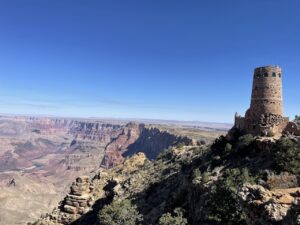
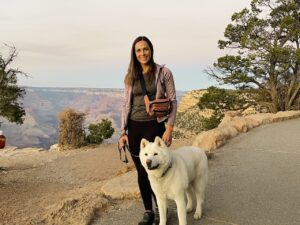
Antelope Point Canyon, Arizona to Hatch, Utah (Oct 16-18)
We stayed in Hatch for a few nights, spending two days in Bryce Canyon and one day at Zion National Park.
Bryce Canyon
Established as a national park in 1928, Bryce Canyon was named after Ebenezer Bryce, a Mormon settler from the late 1800s. The park features unique geological formations, especially its famous hoodoos—tall, thin spires of rock. These formations result from frost-wedging and erosion, creating a surreal landscape.
Visitors are drawn to Bryce Canyon’s dramatic viewpoints. Sunrise Point and Sunset Point are among the most popular. These overlooks provide breathtaking panoramas, especially at dawn and dusk when colors come alive. The park has numerous trails for all levels, with the Navajo Loop and Queen’s Garden Trail being favorites. The Navajo Loop descends into the canyon, winding through a labyrinth of hoodoos for close-up views. For a more leisurely experience, the Rim Trail offers stunning vistas without steep descents.
I spent an extra day here because I was nearing the end of my marathon training. I needed to do one last long run, so I ran 22 miles throughout Bryce Canyon that day.
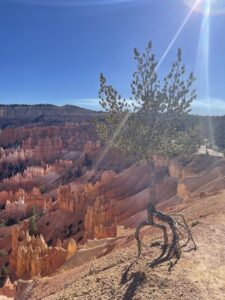
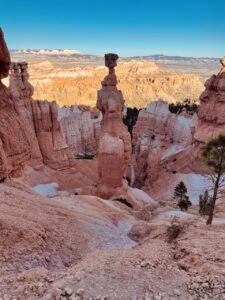
Zion National Park
Zion attracts millions of visitors each year, making it one of the most popular national parks in the U.S. It was our favorite park during this trip, and we regretted spending only one day there.
Originally inhabited by Native American tribes, including the Southern Paiutes, Zion was explored by European settlers in the 19th century. It became Mukuntuweap National Monument in 1909 and officially became Zion National Park in 1919, named after a biblical term for a place of refuge.
Highlights include Angels Landing, known for its challenging hike and amazing views, and the serene Emerald Pools, where cascading waterfalls and lush greenery contrast with rugged rock formations.
Zion’s extensive trail system caters to all hikers, from beginners to seasoned adventurers. The Riverside Walk is a paved trail perfect for families, leading to the stunning Narrows. For more challenge, the Angel’s Landing hike offers a thrilling experience with steep switchbacks and a narrow ridge. The Observation Point trail provides a slightly less strenuous yet equally breathtaking view of Zion Canyon.

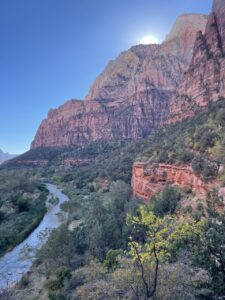
Hatch to Moab, Utah (Oct 19-20)
After leaving Hatch, we visited Canyonlands National Park before arriving in Moab, Utah. From Moab, we visited Arches National Park for the day.
Canyonlands National Park
Established in 1964, Canyonlands encompasses over 337,000 acres of stunning canyons, mesas, and buttes. One highlight is Island in the Sky, a massive plateau offering sweeping views of the canyons below. Visitors can explore various overlooks, such as Mesa Arch, which frames the sunrise beautifully.
Compared to the Grand Canyon, Canyonlands offers a more rugged experience without as many tourists and gift shops.
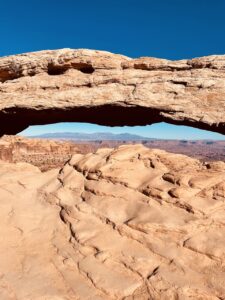
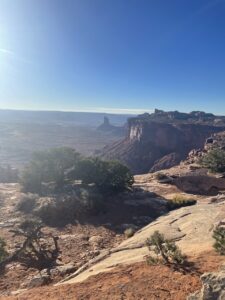
Arches National Park
Arches National Park contains one of the largest concentrations of natural arches in the world. Established as a national monument in 1929 and later designated a national park in 1971, it is home to over 2,000 natural stone arches. One of the park’s most iconic features is Delicate Arch. This stunning free-standing arch stands 65 feet tall and is accessible via a moderately strenuous 3-mile round-trip hike.
Visitors can choose from family-friendly options like the Short Loop in the Windows Section or venture into the challenging Fiery Furnace. The Fiery Furnace is a maze of narrow canyons and arches, accessible only through ranger-led tours or with a permit.

Moab, Utah to Colorado (Oct 21-23)
After leaving Moab, we visited relatives in Colorado. We also explored the Colorado National Monument, Gunnison National Park, and Ouray.
Colorado National Monument
The history of Colorado National Monument dates back to the late 19th century. John Otto was a passionate advocate for the area. He campaigned tirelessly for its preservation. Visitors can explore Otto’s Trail, showcasing stunning vistas and historical significance.
The monument covers over 20,000 acres. It offers hiking, rock climbing, and scenic drives along Rim Rock Drive. The contrast of red rock against the blue sky provides exceptional photography opportunities, especially at sunrise and sunset.
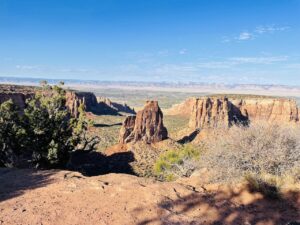
Gunnison National Park
Gunnison National Park is known for its breathtaking Black Canyon. This geological wonder features some of the steepest cliffs in North America. Established in 1999, it showcases sheer rock walls that drop almost 2,700 feet.
The park is named after John W. Gunnison, an explorer who surveyed the area in 1853. The canyon’s unique coloration ranges from deep blacks to vibrant oranges and yellows.
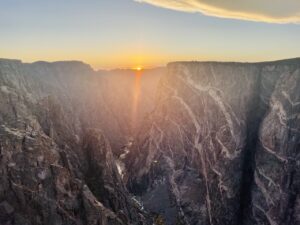
Ouray, Colorado
Ouray is often called the “Switzerland of America.” It is known for stunning alpine scenery and Victorian architecture. Founded during the silver mining boom, Ouray evolved into a popular destination.
The town hosts numerous festivals, including the famous Ouray Ice Festival. This event attracts ice climbers from around the world.
Another attraction is the Million Dollar Highway. Officially known as U.S. Route 550, this road is one of the most scenic drives in the United States. It stretches between Ouray and Silverton, Colorado. The road is famous for its challenging twists and turns. Many consider it an exhilarating or terrifying drive. The highway earned its nickname due to the rumored construction cost. It was said to be equivalent to a million dollars per mile, partly due to the difficult terrain and the gold and silver mines that once flourished in the area.
Colorado to Pennsylvania (Oct 24-27)
As our trip came to a close, we drove home. We alternated drivers every few hours and stopped to sleep for 4-6 hours each night. We preferred driving at night or early morning to avoid traffic.
Reflecting on our journey…
Favorite Park Overall?
Zion National Park
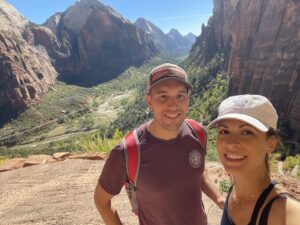
Best Hikes?
Bryce Canyon National Park
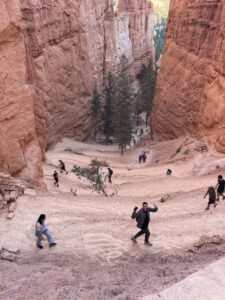
Most Family Friendly?
The Grand Canyon

Best Sunrise and Sunset?
Monument Valley

Most Photogenic or Instagrammable ?
Antelope Canyon

We enjoyed every one of these parks and will forever remember this trip. This trip showcased the beauty of the American Southwest, and we can’t wait for our next adventure!
Check out some of our past adventures:
